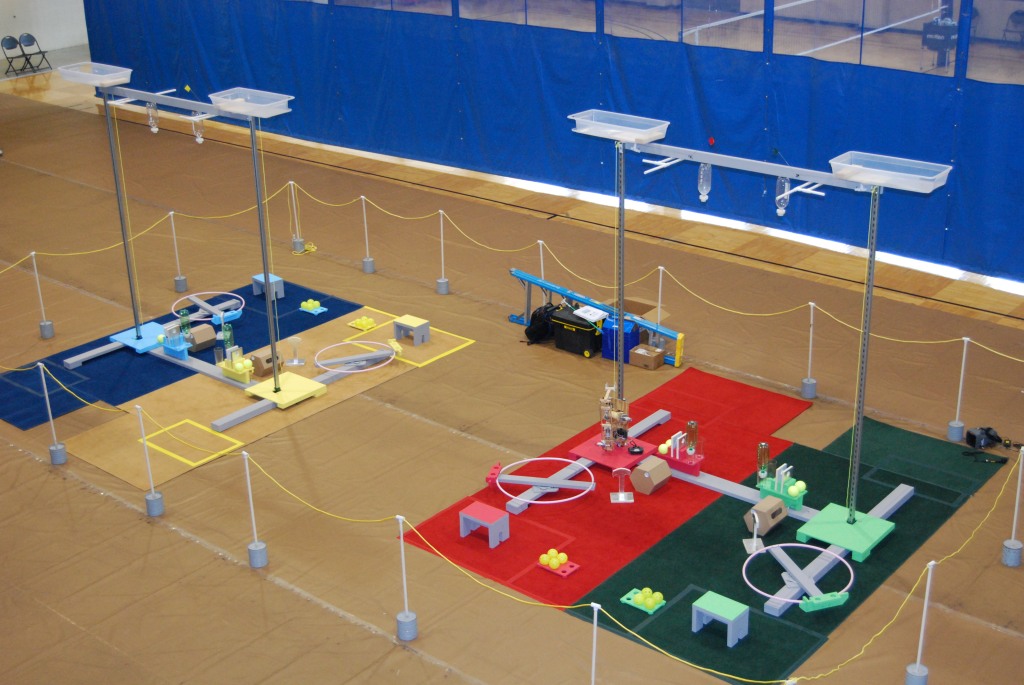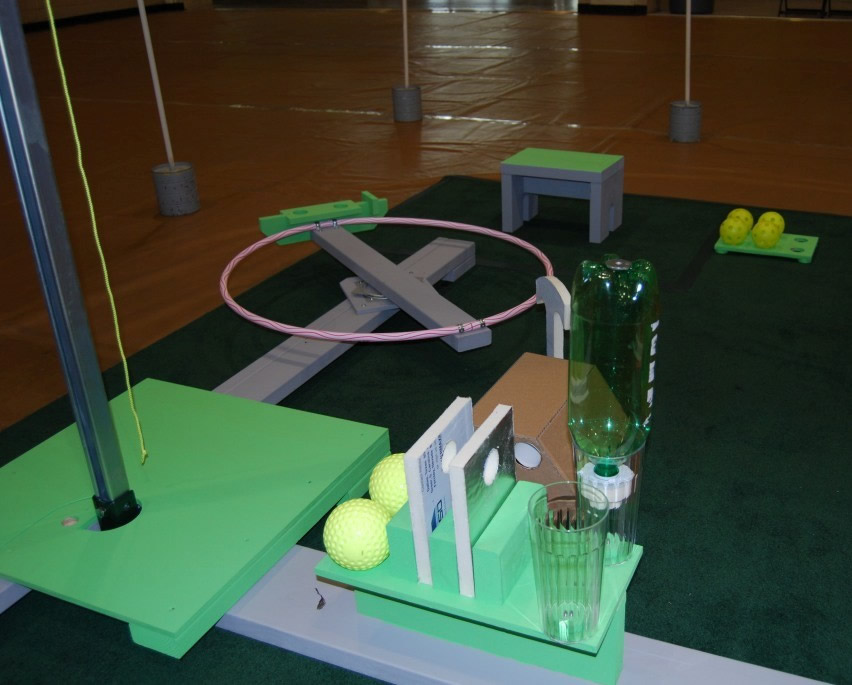WARP XX
(Courtesy of SA BEST)
Teams are tasked with relocating various cargo and equipment located around the ground and space areas of the space elevator system. The field consists of four ten-foot tall space elevators arranged in pairs with a beam across the top of each pair. Near each elevator assembly, there are items that can be either taken into space or brought back from space via the elevator. Halfway up the tower is a mark that defines where the Space Zone begins and the Ground Zone ends. Activities that are allowed in the different zones are described later.

The tower includes a rope which may be manually attached to the robot. At the start of the match, the robot must be in contact with the starting platform located at the base of the tower and must be able to fit within a 24x24x24-inch space that has no specific orientation relative to the field. A field-supplied safety cable must be used to tether the robot to the tower n the event of an unfortunate occurance. There are no requirements regarding the use of the rope or the tower; the designers of the robots may choose how to use these items.
The cargo ship (attached to the rotating hula hoop) is used to transport cargo to and from the robot. The cargo ship is manipulated by the Spotter via the hoop-shaped handle. The Spotter is also responsible for moving Cargo Balls between cargo ship and the spotter rack. The Spotter is located in the arae with the small stool and must remain seated on the stool throughout the match.
As previously mentioned, a number of game pieces are located next to the starting platform as shown in the picture to the right. The game pieces are described in the table below
|
The table that follows contains a summary of the number of game pieces per team, the starting and scoring locations, and the point values. Scoring is determined by the position of the item at the end of the match.
Item |
Points |
Number |
Start Location. |
Scoring Location. |
Waste Cargo |
1 |
2 |
Base Rack |
Spotter Rack |
Light Cargo |
3 |
4 |
Spotter Rack |
Midway Bin |
Green Fuel |
7 |
1 |
Base Rack |
Midway Mount |
Clear Fuel |
5 |
1 |
Midway Mount |
Base Rack |
T-Structure |
8 |
1 |
Floor |
Midway T-slot |
Solar Panel |
6 |
2 |
Base Rack |
Midway stud |
Habitation Module |
12 |
1 |
Floor |
Midway stud |

In addition, bonus points are added to the score when certain goals are met. The table below provides the criteria required for earning one or more scoring bonuses and the bonus value. Note that the Rapid Turnaround Bonus does not require that a robot leaves the Space Zone.
Bonus |
Requirement |
Points |
Fuel Tank |
Score both clear and green fuel bottles. |
4 |
Cargo Diversity |
Score a light cargo ball, a solar panel, and a T-structure. |
9 |
Rapid Turn Around |
Entire robot is below space zone at end of match. |
1 |
Summit |
Toggle the summit indicator. |
2 |
There are a number of restrictions that control game play. A partial list of the restrictions includes:
- The robot must be fully below the Space Zone while interacting with the base rack or cargo ship.
- The robot may incidentally touch the floor, but may not be supported by the floor.
- The robot must be fully above the Space Zone while interacting with the Midway Station.
- Waste Cargo Balls may not be lifted into the Space Zone.
- Robots may not detach mechanisms in the Space Zone
- Teams may not interfere with other teams.
- The Spotter/Driver may not pick up game pieces from the floor or on the robot.
- The Spotter/Driver may not place game pieces on the floor or on the robot..
The contest is comprised of three phases: a partial round robin seeding competition, a six game round robin semi-final between the top eight teams, and a three game round robin final between the top four teams. The team’s average score during the seeding competition (with the lowest score dropped) will be used to rank the team and to determine seven of the eight teams that will advance to the semi-final round robin playoff. The eighth team for the semi-finals will be the winner of a single “wildcard” game. The participants for the wildcard game are selected based on the score of their engineering notebook.
At the start of the semi-finals, the scores will be reset to zero. For the semi-final round robin playoff, the top eight teams will each play three matches. The total of each team’s scores for these three matches will determine which four teams advance to the finals. At the start of the final competition, total scores will again be reset to zero. The top four teams will play three additional matches to determine the final ranking order.

 Announcements
Announcements











